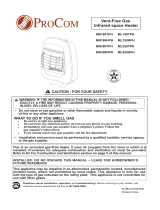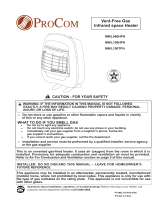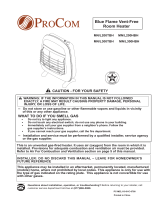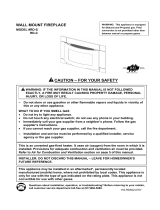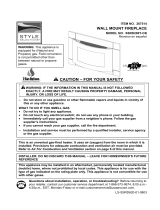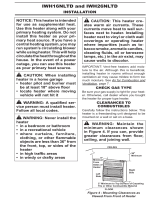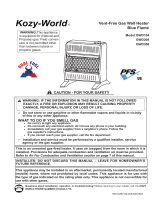Page is loading ...

1
DECORATIVE VENT-FREE WALL HEATER
PC-PCR60M-0807
MODEL NO. PCR60M
CAUTION - FOR YOUR SAFETY
WARNING: IF THE INFORMATION IN THIS MANUAL IS NOT FOLLOWED
EXACTLY, A FIRE OR EXPLOSION MAY RESULT CAUSING PROPERTY
DAMAGE, PERSONAL INJURY, OR LOSS OF LIFE.
--
Do not store or use gasoline or other ammable vapors and liquids in vicinity
of this or any other appliance.
WHAT TO DO IF YOU SMELL GAS
Do not try to light any appliance.
Do not touch any electrical switch; do not use any phone in your building.
Immediately call your gas supplier from a neighbor’s phone. Follow the
gas supplier’s instructions.
Call the re department.
-- Service must be performed by a qualied service agency.
This is a propane -red heater. It uses air (oxygen) from the room in which it is
installed. Provisions for adequate combustion and ventilation air must be provided.
Refer to Air For Combustion and Ventilation section on page 6 of this manual.
INSTALLER: DO NO DISCARD THIS MANUAL – LEAVE FOR HOMEOWNER’S
FUTURE REFERENCE
This appliance may be installed in an aftermarket, permanently located manufactured
(mobile) home, where not prohibited by local codes. This appliance is for use with
the type of gas indicated on the rating plate only. This appliance is not convertible for
use with other gases.
Questions about installation, operation, or troubleshooting? Before returning to your retailer, call
customer service department toll-free at (877)886-5989.

2
2
TABLE OF CONTENTS
MODEL PCR60M
BTU (available) 6,000
Gas Type Propane/LP
Ignition Electric Piezo
Pressure Regulator Setting 9 in. W.C.
Dimensions, Inches (H x W x D)
Heater 20 5/8 x 20 x 7 1/4
Carton 23 1/4 x 22 1/2 x 9 11/16
Weight (Pounds)
Heater 22
Shipping 26.5
PRODUCT SPECIFICATIONS
Important Safety Information ....................................................................................................3
Air For Combustion and Ventilation ....……............................…………..........................................................6
Installation …......................…………………........................................................................................9
Operation ...............…………...................................................................................................................12
Care And Maintenance .................................................................................................................15
Troubleshooting ……………………....................................................................................................16
Replacement Parts ………………....................................................................................................19
IMPORTANT: Read this owner’s manual carefully and completely before trying to assemble, operate, or service
this heater. Improper use of this heater can cause serious injury or death from burns, re, explosion, and carbon
monoxide poisoning.
WARNING: READ THE INSTALLATION & OPERATION INSTRUCTIONS BEFORE USING THIS APPLIANCE.
TABLE OF CONTENTS

333
IMPORTANT SAFETY INFORMATION
IMPORTANT SAFETY INFORMATION
IMPORTANT: Read this owner’s manual carefully and completely before trying to assemble, operate, or service
this heater. Improper use of this heater can cause serious injury or death from burns, re, explosion, and carbon
monoxide poisoning.
Only a qualied, service agent, may service this product.
WARNING: Do not store or use gasoline or other ammable vapors and liquids in the vicinity of this or any
other appliance.
CARBON MONOXIDE POISONING: Early signs of carbon monoxide poisoning resemble the u with headache,
dizziness and/or nausea. If you have these signs, heater may not be working properly. Get fresh air at once!
Have heater serviced. Some people - pregnant women, persons with heart or lung disease, anemia, those
under the inuence of alcohol, those at high altitude are more affected by carbon monoxide than others.
PROPANE/LP GAS: Propane/LP gas is odorless. An odor-producing agent is added to the gas. The odor helps
you detect a gas leak. However, the odor added to the gas can fade. Gas may be present even though no odor
exists.
WARNING: Any change to this heater or its controls can be dangerous.
WARNING: Do not use any accessories not approved for use with this heater.
WARNING: Carefully supervise young children when they are in the room with the heater.
WARNING: Make sure front panel assembly is in place before running heater.
WARNING: Keep the appliance area clear and free from combustible materials, gasoline, and other
ammable vapors and liquids.
WARNING: Due to high temperatures, the appliance should be located out of trafc and away from furniture
and draperies.
WARNING: Heater becomes very hot when running . Keep children and adults away from hot surfaces to
avoid burns or clothing ignition. Heater will remain hot for a time after shutoff. Allow surfaces to cool before
touching.
WARNING: Do not place clothing or other ammable material on or near the appliance. Never place any
objects in the heater.
WARNING: Improper location, adjustment, alteration, service or maintenance can cause property damage,
personal injury or loss of life. Refer to the owner's information manual provided with this heater.
WARNING: Risk of Fire - Keep all combustible material, such as furniture, papers, clothes and curtains, at
least 3 ft (0.9 m) from the front of the heater system.
CAUTION: Hot while in operation. Do not touch. Keep children away.
WARNING: Risk of Fire – Do not operate heater system in area whereammable liquids or vapors are
present.
WARNING: Failure to keep combustible materials, gasoline and other ammable vapors and liquids away
from the heater system may result in a re or explosion.
WARNING: Do not allow fans or any other drafts that alter burner ame to blow directly into the heater. They
create drafts that alter burner ame patterns, which can cause sooting.
WARNING: Failure to keep the primary air openings of the burner clean may result in the production of
carbon monoxide and loss of life.

44
PRODUCT FEATURES
SAFETY PILOT
This heater has a pilot with an Oxygen Depletion Sensing (ODS) safety shutoff system. The ODS/pilot shuts off the
heater if there is not enough fresh air.
PIEZO LGNITION SYSTEM
This heater is equipped with an electronic piezo control system. This system requires AAA batteries (provided).
LOCAL CODES
Install and use heater with care. Follow all local codes. In the absence of local codes, use the latest edition of The
National Fuel Gas Code, ANSI Z223.1/ NFPA 54
.
*Available from:
American National Standards Institute, lnc.
1430 Broadway
New York, NY 10018
National Fire Protection Association, lnc.
1 Batterymarch Park
Quincy, MA 02269-9101
In the State of Massachusetts, unvented gas-red space heaters shall be prohibited in bedrooms and bathrooms.
1. This appliance is for use with only the type of gas indicated on the rating plate. This appliance is not
convertible for use with other gases.
2. This heater needs fresh air ventilation to run properly. This heater has an Oxygen Depletion Sensing (ODS) safety
shutoff system. The ODS shuts down the heater if not enough fresh air is available. See Air for Combustion and
Ventilation, pages 6 through 8. If heater keeps shutting off, see Troubleshooting, pages 16 through 18.
3. Keep all air openings in front and bottom of heater clear and free of debris. This will ensure enough air for proper
combustion.
4. If heater shuts off, do not relight until you provide fresh, outside air. If heater keeps shutting off, have it serviced.
5. Do not run heater:
Where ammable liquids or vapors are used or stored.
Under dusty conditions.
6. Before using furniture polish, wax, carpet cleaner, or similar products, turn heater off. If heated, the vapors from
these products may create a white powder residue within burner box or on adjacent walls or furniture.
7. Always run heater with control knob at PILOT/IGN, LOW or HIGH locked positions. Never set control knob
between locked positions. Poor combustion and higher levels of carbon monoxide may result.
8. Do not use heater if any part has been under water. Immediately call a qualied service technician to inspect
the room heater and to replace any part of the control system and any gas control which has been under water.
9. Turn off heater and let cool before servicing. Only a qualied service person should service and repair heater.
10. Operating heater above elevations of 4,500 feet could cause pilot outage.
QUALIFIED SERVICE AGENCY
Only a qualied agency should repair and service heater. The term “qualied agency” means any individual,
rm, corporation, or company that either in person or through a representative is engaged in and is responsible for:
Repairing, or servicing equipment; that is experienced in such work; that is familiar with all precautions required;
and that has complied with all the requirement of the authority having jurisdiction.
•
•

55
Before beginning assembly or operation of the product, make sure all parts are present. Compare parts with package
contents list and diagram above. If any part is missing or damaged, do not attempt to assemble, install or operate the
product. Contact customer service for replacement parts.
Before installing heater, make sure you have the items listed below:
Tape measure
Level
9/64 inch drill bit
Drill
Screwdriver
UNPACKING
1. Remove heater from carton.
2. Remove all protective packaging applied to
heater for shipping
3. Check heater for any shipping damage.
If heater is damaged, promptly inform
dealer where you bought heater.
•
•
•
•
•
Figure 1- Vent - Free Gas Heater
PREPARING FOR INSTALLATION
WATER VAPOR: A BY-PRODUCT OF UNVENTED ROOM HEATERS
Water vapor is a by-product of gas combustion. An unvented room heater produces approximately one (1) ounce
(30 mL) of water for every 1,000 BTUs (.3 kw) of gas input per hour. Unvented room heaters are recommended
as supplemental heat (a room) rather than a primary heat source (an entire house). In most supplemental heat
applications, the water vapor does not create a problem. In most applications, the water vapor enhances the low
humidity atmosphere experience during cold weather.
The following steps will help insure that water vapor does not become a problem.
1. Be sure the heater is sized properly for the application, including ample combustion air and circulation air.
2. If high humidity is experienced, a dehumidier may be used to help lower the water vapor content of the air.
3. Do not use an unvented room heater as the primary heat source.

66
AIR FOR COMBUSTION AND VENTILATION
WARNING: This heater should not be installed in a confined space or unusually tight construction unless
provisions are provided for adequate combustion and ventilation air. Read the following instructions to insure
proper fresh air for this and other fuel-burning appliances in your home.
Providing Adequate Ventilation
The following are excerpts from National Fuel Gas Code, NFPA 54/ANSI Z223.1. Air for Combustion and Ventilation. All
spaces in homes fall into one of the three following ventilation classications:
1. Unusually Tight Construction
2. Unconned Space
3. Conned Space
The information on pages 7 through 9 will help you classify your space and provide adequate ventilation.
Conned and Unconned Space
The National Fuel Gas Code, ANSI Z223.1/NFPA 54 denes a conned space as a space whose volume is less than
50 cu. ft. per 1,000 BTU/hr (4.8 m^3 per kw) of the aggregate input rating of all appliances installed in that space and
an unconned space as a space whose volume is not less than 50 cubic feet per 1,000 BTU/hr (4.8 m^3 per kw) of
the aggregate input rating of all appliances installed in that space. Rooms connecting directly with the space in which
the appliances are installed*, through openings not furnished with doors, are considered a part of the unconned
space.
This heater shall not be installed in a conned space or unusually tight construction unless provisions are provided for
adequate combustion and ventilation air.
* Adjoining rooms are connecting only if there are doorless passageways or ventilation grills between them.
Unusually Tight Construction
The air that leaks around doors and windows may provide enough fresh air for
combustion and ventilation. However, in buildings of unusually tight construction, you
must provide additional fresh air.
Unusually tight construction is dened as construction where:
Walls and ceilings exposed to the outside atmosphere have a continuous water vapor retarder with a rating of
one perm (6×10
-11
kg per pa-sec-m
2
) or less with openings gasketed or sealed and
Weather stripping has been added on openable windows and on doors and
Caulking or sealants are applied to areas such as joints around window and door frames, between sole plates
and oors, between wall ceiling joints, between wall panels, at penetrations for plumbing, electrical, and gas
lines, and at other openings.
If your home meets all of the three criteria above, you must provide additional fresh air. See “Ventilation Air From
Outdoors”. If your home does not meet all of the three criteria above, proceed to “Determining Fresh-Air Flow For
Heater Location”.
a)
b)
c)

77
DETERMINING FRESH-AIR FLOW FOR HEATER LOCATION
Example:
Gas water heater 30,000 BTU/hr
Vent-free heater + 26,000 BTU/hr
Total = 56,000 BTU/hr
BTU/hr
BTU/hr
BTU/hr
BTU/hr
BTU/hr
BTU/hr
BTU/hr
Vent-free heater
Gas water heater*
Gas furnace
Vented gas heater
Gas heater logs
Other gas appliances* +
Total =
c) Install a lower BTU/hr heater if lower BTU/hr size makes room unconned. If the actual BTU/hr used is less
than the maximum BTU/hr the space can support, the space is an unconned space. You will need no ad
ditional fresh air ventilation.
Determining if You Have a Conned or Unconned Space
Use this worksheet to determine if you have a conned or unconned space.
Space: Includes the room in which you will install heater plus any adjoining rooms with doorless passageways or
ventilation grills between the rooms.
1. Determine the volume of the space Length × Width × Height =
cu. ft. (volume of space)
Example: Space size 20 ft. (length) × 16 ft. (width)×8 ft. (ceiling height) =2560 cu. ft. (volume of space)
If additional ventilation to adjoining room is supplied with grills or openings, add the volume of these rooms to the
total volume of the space.
2. Divide the space volume by 50 cubic feet to determine the maximum BTU/hr the space can support.
(volume of space) ÷ 50 cu. ft. = (Maximum BTU/hr the space can support)
3. Add the BTU/hr of all fuel burning appliances in the space.
*Do not include direct-vent gas appliances. Direct-vent draws combustion air from
the outdoors and vents to the outdoors.
4. Compare the maximum BTU/hr the space can support with the actual amount of
BTU/hr used
. BTU/hr (maximum the space can support)
BTU/hr (actual amount of BTU/hr used)
Example : 51,200 BTU/hr (maximum the space can support)
56,000 BTU/hr (actual amount of BTU/hr used)
The space in the above example is a conned space because the actual BTU/hr used is more than the maximum
BTU/hr the space can support.
You must provide additional fresh air. Your options are as follows:
Rework worksheet, adding the space of an adjoining room. If the extra space provides an unconned space,
remove door to adjoining room or add ventilation grills between rooms. See “ Ventilation Air From Inside Building
on page 8”.
Vent room directly to the outdoors. See “ Ventilation Air From Outdoors on page 8”.
a)
b)

88
Figure 2 - Ventilation Air from Inside Building
Figure 3 - Ventilation Air from Outdoors
Ventilation Air From lnside Building
This fresh air would come from an adjoining
unconned space. When ventilating to an
adjoining unconned space, you must provide
two permanent openings: one within 12 inches
of the ceiling and one within 12 inches of the
oor on the wall connecting the two spaces
(see options 1 and 2, Figure 2). You can also
remove the door into adjoining room (see
option 3, Figure 2). Follow the National Fuel
Gas Code. NFPA 54/ANSI Z223.1. Air for
Combustion and Ventilation for required size
of ventilation grills or ducts.
Ventilation Air From Outdoors
Provide extra fresh air by using ventilation
grills or ducts. You must provide two permanent
openings: one within 12 inches of the ceiling
and one within 12 inches of the oor. Connect
these items directly to the outdoors or spaces
open to the outdoors. These spaces include
attics and crawl spaces. Follow the National
Fuel Gas Code, NFPA 54/ANSI Z223.1. Air for
Combustion and Ventilation for required size of
ventilation grills or ducts.
IMPORTANT: Do not provide openings
for inlet or outlet air into attic if attic has
a thermostat-controlled power vent.
Heated air entering the attic will activate
the power vent. Rework worksheet, adding
the space of the adjoining unconned space.
The combined spaces must have enough
fresh air to supply all appliances in both spaces.
CAUTION: If the area in which the heater may be operated is smaller than that dened as an unconned
space or if the building is of unusually tight construction, provide adequate combustion and ventilation air by
one of the methods described in the National Fuel Gas Code, ANSI Z223.1/NFPA, Air for Combustion and
Ventilation or applicable local codes.

99
This heater use a 1lb. propane cylinder. The heater is made to fasten to the wall.
WARNING: When this heater is not in use, the gas supply must be turned off. Propane gas cylinder must be
disconnected when a disposable cylinder is used.
WARNING:Only disposable cylinder marked with the proper fuel type approved for the appliance. It is dangerous
to use a dented or rusty cylinder.
WARNING: When the heater is used for emergency home heating use, never bring a rellable propane cylinder
indoors.
1) Open cylinder cover panel on left side of heater.
2) Connect 1lb. disposable cylinder to regulator by turning clockwise.
3) Before operation make sure control knob is on OFF position, and apply a mixture of liquid soap and water to all
joints. Make sure all the joints have been connected properly close cylinder access panel.
Attach to 1lb. cylinder regulator inlet. (see Figure 4)
Figure 4 Connecting propane cylinder
INSTALLATION
NOTICE: This heater is intended for use as
supplemental heat. Use this heater along with
your primary heating system. Do not install
this heater as your primary heat source.
If you have a central heating system, you
may run system’s circulating blower while
using heater. This will help circulate the
heat throughout the house. In the event of
a power outage, you can use this heater
as your primary heat source.
CAUTION: If you install the heater in a
home garage:
Heater pilot and burner must be at least 18
in. above the oor.
Place heater where moving vehicle will not
hit it.
WARNING: Never install the heater
in a recreational vehicle
where curtains, furniture, clothing, or other
ammable objects are less than 36 inches
from the front, top, or sides of the heater
in high trafc areas
in windy or drafty areas
•
•
•
•
•
•

1010
Figure 5 - Mouting clearances as
viewed from front of heater
13
13
MIN
MIN
13
MIN
13
MIN
Figure 6 - Mounting screws clearances
17 1/2 in.
30
Figure 7
WARNING: Maintain the minimum clearances
shown in Figure 5. If you can, provide greater
clearances from oor, ceiling, and joining wall.
CAUTION: This heater creates warm air currents.
These currents move heat to wall surfaces next to
heater. Installing heater next to vinyl or cloth wall
coverings or operating heater where impurities
(such as tobacco smoke, aromatic candles, cleaning
uids, oil or kerosene lamps, etc.) in the air exist,
may discolor walls.
Clearances To Combustibles
Carefully follow the instructions below.
FASTENING HEATER TO WALL
Methods For Attaching Heater To Wall
Attach heater to wall in only one of two ways:
1. To wall stud
Attaching to Wall Stud: This method provides
the strongest hold.
2. To wall anchor
Attaching to Wall Anchor: This method allows
you to attach heater to hollow walls (wall areas
between studs) or to solid walls (concrete or
masonry). Decide which method better suits
your needs. Either meth will provide a secure
hold for the heater.
Mark screw locations on wall (see Figure 6).
Attaching Mounting screws To Wall
Note: Mounting screws are in hardware
package. The hardware package is
provided with heater.
Attaching to Wall Stud Method
1. Drill holes at marked locations using
9/64-inch drill bit.
2. Insert mounting screws into wall studs.
tighten screws to leave a 1/8 - 1/4 inch
space from back of screw to wall. (see gure 7)
1/8 - 1/4 inch

11
Attaching to Wall Anchor Method
For attaching heater to hollow walls (wall are as
between studs) or solid walls (concrete or masonry):
1. Drill holes at marked locations using 5/16 -in.
drill bit. For solid walls (concrete or masonry),
drill at least 1-in. deep.
2. Fold wall anchor as shown in Figure 8.
3. Insert wall anchor (wings rst) into hole.
Tap anchor ush to wall.
4. For thin walls, (1/2 -in. or less), insert key
into wall anchor. Push key to “pop” open
anchor winds (see Figure 9).
IMPORTANT: Do not hammer key! For thick
walls (over ½ -in. thick) or solid walls, do not
pop open wings.
5. Insert mounting screws through into wall
anchors, tighten screws to leave a 1/8 - 1/4
inch space from back of screw to wall.
Placing heater On Vertical Screws
1. Locate two horizontal slots on back
panel of heater (see gure 10)
2. Place heater onto screws.
Figure 10 - Mounting Heater Onto
Mounting Screws
Vertical
Figure 8- Folding Anchor
Figure 9- Popping Open
Anchor Wing for Thin Walls

1212
OPERATION
FOR YOUR SAFETY READ BEFORE LIGHTING
WARNING: If you do not follow these instructions exactly, a re or explosion may result causing property
damage, personal injury or loss of life.
When lighting the pilot, follow these instructions exactly.
BEFORE LIGHTING, smell all around the appliance area for gas. Be sure to smell next to the oor be-
cause some gas is heavier than air and will settle on the oor.
Use only your hand to push in or turn the gas control knob. Never use tools. If the knob will not push in or
turn by hand, don’t try to repair it, call a qualied service technician or gas supplier. Forced or attempted
repair may result in a re or explosion.
Do not use this appliance if any part has been under water. Immediately call a qualied service technician
to inspect the appliance and to replace any part of the control system and any gas control which has been
under water.
WHAT TO DO IF YOU SMELL GAS
Do not try to light any appliance.
Do not touch any electric switch, do not use any phone in your building.
Immediately call your gas supplier from a neighbor’s phone. Follow the gas supplier’s instructions.
If you cannot reach your gas supplier, call the re department.
LIGHTING INSTRUCTIONS
1. STOP! Read the safety information on the front and back of warning plates.
2. Check that gas supply to heater is connected to heater.
3. Push in gas control knob slightly and turn clockwise to the OFF position.(see Figure 11)
4. Wait ve (5) minutes to clear out any air gas. Then smell for gas, including near the oor. If you smell gas,
STOP! Follow “B” in the safety information on the warning plate. If you do not smell gas, go to the next
step.
5. Push in gas control knob slightly and turn counterclockwise to“PILOT/IGN” position. Press in control
knob for ve (5) seconds (see Figure 11).
Note: The rst time that the heater is operate after connecting the gas supply,the control knob should be
depressed for about thirty(30) seconds.This will allow air to bleed from the system.
6. With control knob pressed in, push down and release ignitor button. This will light pilot. If needed, keep
pressing ignitor button until pilot lights.
7. Keep control knob depressed for ten (10) seconds after lighting pilot. If pilot goes out repeat steps 5,6 and 7.
8. Turn control knob counterclockwise to ON position. The burner should light.
A.
B.
C.
D.
•
•
•
•

1313
Figure 13- Control Knob Postitions
POSITION
POSITION
POSITION
TO TURN OFF GAS TO APPLIANCE
Shutting Off Heater
Turn control knob clockwise to the OFF
position.
Shutting Off Burner Only (pilot stays lit )
Turn control knob clockwise to the PILOT/ IGN position.
Never set control knob between locked positions. Poor combus-
tion and higher levels of carbon monoxide may result.
Figure 12- Pilot
Figure 11- Control Knob in OFF Position

1414
INSPECTING BURNER
Check pilot ame pattern and burner ame pattern often.
PILOT FLAME PATTERN
Figure 14 shows a correct pilot ame pattern. Figure 15 shows an incorrect pilot ame pattern. The incorrect pilot
ame is not touching the thermocouple. This will cause the thermocouple to cool. When the thermocouple cools, the
heater will shut down. If pilot ame pattern is incorrect, as shown in Figure 15.
turn heater off (see “To Turn Off Gas to Appliance” on page 13)
see Troubleshooting pages 16 through 18.
Notice: Do not mistake orange ames with yellow tipping. Dirt or other ne particles enter the heater and burn causing
brief patches of orange ame.
BURNER FLAME PATTERN
Figure 16 shows a correct burner ame pattern. Figure 17 shows an incorrect burner ame pattern. If burner ame
pattern is incorrect, as shown in Figure 17.
Turn heater off (see “To Turn Off Gas to Appliance” on page 13).
See Troubleshooting, pages 16 through 18.
•
•
•
•
Figure 14 - Correct Pilot Flame Pattern
Figure 15 - Incorrect Pilot Flame Pattern
Figure 16 - Correct Burner
Flame Pattern
Figure 17 - Incorrect Burner
Flame Pattern

1515
CARE AND MAINTENANCE
WARNING: Turn off heater and let cool before servicing.
CAUTION: You must keep control areas, burner, and circulating air passageways of heater clean. Inspect these
areas of heater before each use. Have heater inspected yearly by a qualied service technician. Heater may
need more frequent cleaning due to excessive lint from carpeting, bedding material, pet hair, etc.
ODS/PILOT AND BURNER
Use a vacuum cleaner, pressurized air, or a small, soft bristled brush to clean.
CLEANING BURNER PILOT AIR INLET HOLE
We recommend that you clean the unit every 2,500 hours of operation or every three months. We also recommend that
you keep the burner tube and pilot assembly clean and free of dust and dirt. To clean these parts we recommend using
compressed air no greater than 30 PSl. Your local computer store, hardware store, or home center may carry compressed
air in a can. You can use a vacuum cleaner in the blow position. If using compressed air in a can, please follow the direc-
tions on the can. If you don’t follow directions on the can, you could damage the pilot assembly.
1. Shut off the unit, including the pilot. Allow the unit to cool for at least thirty minutes.
2. Inspect burner and pilot for dust and dirt.
3. Blow air through the ports/slots and holes in the burner.
Also clean the pilot assembly. A yellow tip on the pilot
ame indicates dust and dirt in the pilot assembly. There is a small pilot air inlet hole about two inches from where
the pilot ame comes out of the pilot assembly (see Figure 18). With the unit off, lightly blow air through the air
inlet hole. You may blow through a drinking straw if compressed air is not available.
•
CABINET
Air Passageways
Use a vacuum cleaner or pressurized air to clean.
Exterior
Use a soft cloth dampened with a mild soap and water mixture.
Wipe the cabinet to remove dust.
•
•
•
Figure 18 - Pilot Inlet Air Hole

1616
PROBLEM
When ignitor button is
pressed in, there is no
spark at ODS/pilot.
When ignitor button is
pressed in, there is a
spark at ODS/pilot but
no ignition.
ODS/pilot lights but
ame goes out when
control knob is
released.
POSSIBLE CAUSE
1. Ignitor electrode is positioned wrong.
2. Ignitor electrode is broken.
3. Ignitor electrode is not
connected to ignitor cable.
4. Ignitor cable is pinched or wet.
5. Broken ignitor cable.
6. Bad piezo ignitor.
1. Depleted gas supply.
2. Control knob not fully pressed in while
pressing ignitor button.
3. ODS/pilot is clogged.
4. Gas regulator setting is not correct.
5. Control knob not in PILOT position.
1. Control knob is not fully pressed in.
2. Control knob is not pressed in long
enough.
3. Thermocouple connection is loose
at control valve.
4. Thermocouple damaged.
5. Control valve damaged.
REMEDY
1. Replace ignitor.
2. Replace ignitor.
3. Reconnect ignitor cable.
4. Free ignitor cable if pinched by any
metal or tubing. Keep ignitor cable dry.
5. Replace ignitor cable.
6. Replace piezo ignitor.
1. Replace LP Cylinder.
2. Fully press in control knob while press
-
ing ignitor button.
3. Clean ODS/pilot (see
Care and
Maintenance, page 15) or replace ODS/
pilot assembly.
4. Replace gas regulator.
5. Turn control knob to PILOT position.
1. Press in control knob fully.
2. After ODS/pilot lights, keep control
knob pressed in 30 seconds.
3 Hand tighten until snug, and then
tighten 1/4 turn more.
4. Replace thermocouple.
5. Contact customer service.
TROUBLESHOOTING
WARNING: If you smell gas
Do not try to light any appliance.
Do not touch any electrical switch; do not use any phone in your building.
Immediately call your gas supplier from a neighbor’s phone. Follow the gas supplier’s instructions.
Call the re department.
IMPORTANT: Operating heater where impurities in air exist may create odors. Cleaning supplies, paint,
paint remover, cigarette smoke, cements and glues, new carpet or textiles, etc., create fumes. These
fumes may mix with combustion air and create odors.
WARNING: Only a qualied service technician should service and repair heater.
CAUTION: Never use a wire, needle, or similar object to clean ODS/pilot. This can damage ODS/ pilot unit.
Note: All troubleshooting items are listed in order of operation.
•
•
•
•

1717
PROBLEM
Burner(s) does not light after
ODS/pilot is lit.
Delayed ignition of
burner(s).
Burner backring during
combustion.
High Yellow ame during
burner combustion.
Slight smoke or odor
during initial operation.
Heater produces a
whistling noise when
burner is lit.
TROUBLESHOOTING
POSSIBLE CAUSE
1. Burner orice is clogged.
2. Burner orice diameter is too
small.
3. Inlet gas pressure is too low.
1. Inlet gas pressure is too low.
2. Burner orice is clogged.
1. Burner orice is clogged or
damaged.
2. Burner is damaged.
1. Not enough air.
2. Inlet gas pressure is too low.
1. Residues from manufacturing
processes.
1. Air in gas line.
2. Air passageways on heater are
blocked.
3. Dirty or partially clogged burner
orice.
POSSIBLE CAUSE
1. Clean burner orice (see Care
and Maintenance, page 15) or
replace burner orice.
2. Replace burner orice.
3. Replace LP Cylinder.
1. Replace LP Cylinder.
2. Clean burner (see Care and
Maintenance, page 15) or
replace burner orice.
1. Clean burner orice (see Care
and Maintenance, page 15) or
replace.
2. Contact customer service.
1. Check burner for dirt and debris.
If found, clean burner (see Care
and Maintenance, page 15).
2. Replace LP Cylinder
1. Problem will stop after a few
hours of operation.
1. Operate burner until air is
removed from line. Have gas
line checked by local gas supplier.
2. Observe minimum installation
clearances (Figure 5, page 10).
3. Clean burner (see
Care and
Maintenance, page 16) or replace
burner orice.

1818
PROBLEM
Heater produces a clicking/
ticking noise just after
burner is lit or shut off.
White powder residue
forming within burner
box or on adjacent walls
or furniture.
Heater produces
unwanted odors.
Heater shuts off in use
(ODS operates).
Gas odor exists even
when control knob is in
OFF position.
Gas odor during
combustion.
Moisture/condensation
noticed on windows.
POSSIBLE CAUSE
1. Metal is expanding while
heating or contracting while
cooling.
1. When heated, the vapors
from furniture polish, wax,
carpet cleaners, etc., turn into
white powder residue.
1. Heater is burning vapors
from paint, hair spray, glues,
etc. (See IMPORTANT
statement page 16).
2. Gas leak. See Warning Statement
at the top of page 16.
3. Low fuel supply.
1. Not enough fresh air is available.
2. ODS/pilot is partially clogged.
'
1. Control valve is defective.
1. Foreign matter between control valve
and burner.
1. Not enough combustion/ventilation air.
REMEDY
1. This is common with most heaters. if
noise is excessive, contact qualied
service technician.
1. Turn heater off when using furniture
polish, wax, carpet cleaner, or similar
products.
1. Ventilate room. Stop using
odor causing products while
heater is running.
2. Locate and correct all leaks .
3. Replace LP Cylinder
1. Open window and/or door for
ventilation.
2. Clean ODS/pilot (see
Care and
Maintenance, page 15).
1.
Contact customer service.
1. Take apart gas tubing and remove
foreign matter.
1. Refer to Air for “Combustion and
Ventilation” requirements page 6.

1919
REPLACEMENT PARTS
NOTE: Use only original replacement parts. This will protect your warranty coverage for parts replaced under
warranty.
PARTS UNDER WARRANTY
Contact authorized dealers of this product. If they can’t supply original replacement parts, call Customer Service toll
free at
(877)886-5989
for referral information.
When calling Customer Service or your dealer, have ready:
• Your name
• Your address
• Model and serial number of your heater
• How heater was malfunctioning
• Purchase date
• Usually, we will ask you to return the defective part to the factory
PARTS NOT UNDER WARRANTY
Contact authorized dealers of this product. If they can’t supply original replacement part(s) call Customer Service
toll free at
(877)886-5989
for referral information.
When calling Customer Service have ready:
• Model number of your heater
• The replacement part number

2020
This list contains replaceable parts for your heater. When ordering replacement parts, follow the instructions
listed under Replacement Parts on page 19 of this manual.
PARTS LIST
KEY NO. PART NUMBER DESCRIPTION QTY
1 SRL60HA100 Front panel assembly 1
2 FE32A155 Punchy magnet 8
3 ND1908X400 ODS 1
4 ML083-02 Ignitor 1
5 Mounting screws 2
6 MCL082-01 Valve knob 1
7 ML073-03 Ignitor cable 1
8 SRL60HA146 Top heat deflection panel 1
Printed in China
/
